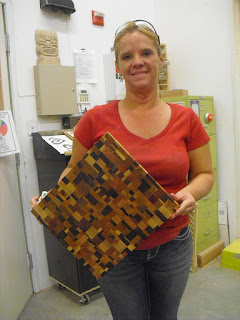It really is rewarding to rebuild an old tool - and the work on the Makita 2040 planer is progressing smoothly. In the first post about this, I discussed taking out the old rollers, to have some work done on them.
These rollers were in horrible shape! The foam on them had rotted, and they were sticky and impregnated with bits of sawdust.
These rollers were in horrible shape! The foam on them had rotted, and they were sticky and impregnated with bits of sawdust.
An Internet searching led me to Western Roller Corporation in Bend, Oregon. They couldn't have been more helpful, and knew exactly what I was talking about when I mentioned these particular rollers.
I packed and sent them off, and started doing some final adjustments to the other rollers on the bed of the planer.
This was very simple stuff - involving some straight edges and feeler gauges. If you're going to work on old machinery, you're going to need a GOOD straight edge!
Adjusting the bottom rollers would have been easier if the manual wasn't so lame.
The manual only gives you basic instructions, so it's up to you to figure out the tolerances you need.
The bed rollers were adjusted to be just slightly above the bed surface - that way the boards slide just above the surface of the bed.
And those two rollers were adjusted, I put a long straight edge across the whole planer, to adjust the two outside roller supports.
This all sounds tricky, but honestly - it was the easiest part of the whole job. Here you can see the roller is too low, by about a quarter inch.
When I'm working on tools, I often wish I had an extra pair of hands - but clamps work just as well. With the straightedge clamped down, it was a breeze to adjust the two outside rollers into the correct position.
The re-covered rollers came back in about two weeks - covered with a neon chartreuse polyurethane material. Damn, I forgot to take a picture of them before we started installing them - but suffice it to say that WRC did an EXCELLENT job covering them for about $90 a roller. New rollers cost close to $300 a piece, so covering them was the best option.
Installing the newly covered rollers was just a bit tricky, and it helped to have an extra set of hands. As always, Eric is a godsend in the shop. He loves working on tools as much as I do! (Thanks for taking all the photos, Lupe!)
Each end of the roller had to fit into a small bushing, and then secured in place with a plate and a couple of screws. the only difficult part was the spring that had to also be inserted. The spring put downward pressure on the roller, while we needed to compress it in order to attach the roller in place.
The picture below really shows what was involved, and we used a large block of wood under the roller (while raising the table) to compress the springs.
Once the roller was in place, it was easy to screw the plate into place. There is not a lot of room for your hands, but I've worked in more cramped spaces than this.
It took a couple of attempts before we muscled everything into place.
The first roller took a while, maybe a half hour, but once we got to the second roller... piece of cake! It went in very quickly.
Next was re-attaching the sprockets on the ends of rollers, and then mounting the chain, which was thoroughly cleaned. There was a crust of 30 year old grime on it!
The chain went back together using its master link, and then we buttoned everything up - attaching the guards back into place, and the dust hood on top.
Time to fire it up!
Let me just say that the surface of this wood after it was planed was remarkable. It felt nearly as smooth as hand-planed wood, with a perfect sheen and absolutely no chattering or machine marks. Seriously, if you were building something with this wood, you could probably start sanding with 180 grit paper, right out of the planer. Maybe even 220 paper.
So there you have it - a 32 year old planer that works as well today as it did when it was new. This is one of those times when I'm reminded that buying good quality tools is always preferable to saving a few dollars.































































